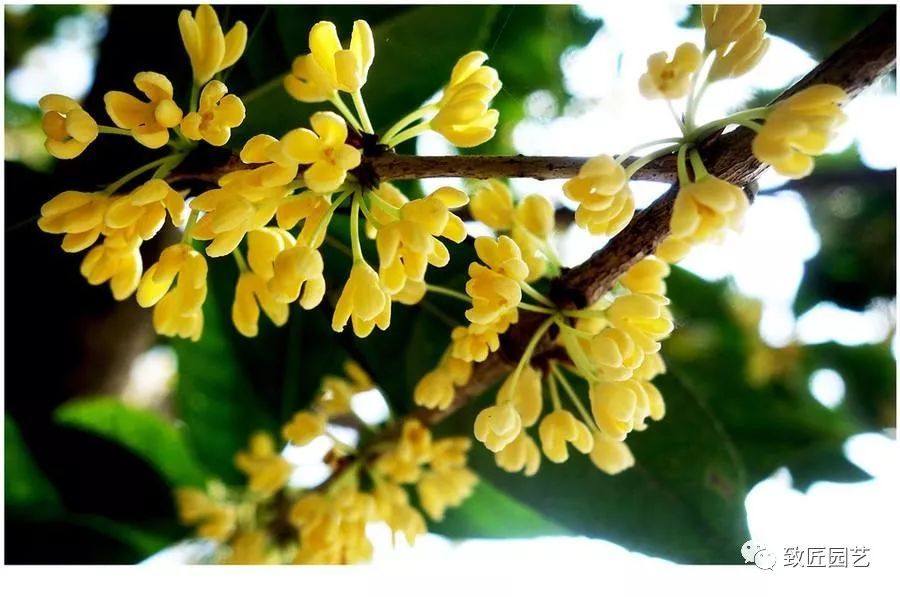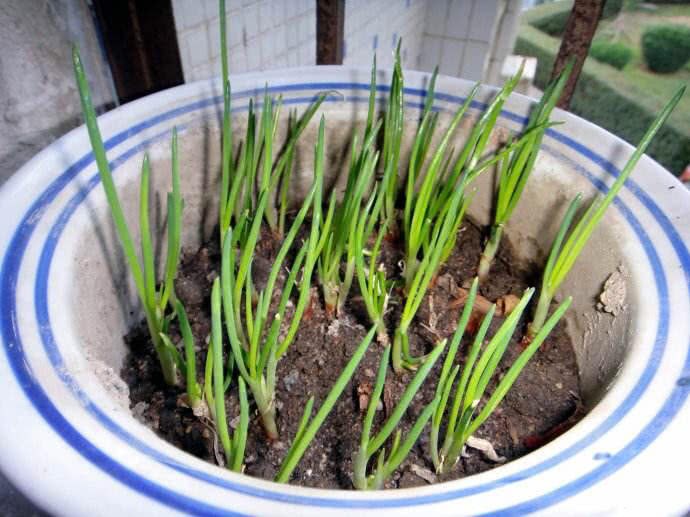The bonsai of sweet-scented osmanthus looks good and smells good. Just choose him.

Sweet-scented osmanthus is evergreen all the year round, with luxuriant branches and luxuriant leaves, blooming in autumn and overflowing with fragrance. It is widely used in gardens. It is often used as landscape trees, such as solitary planting, opposite planting, and forest planting. What is the planting technology of bonsai sweet-scented osmanthus trees? What is the management method of sweet-scented osmanthus bonsai culture?
Cultivation techniques of sweet-scented osmanthus bonsai
1. Selection of pots: sweet-scented osmanthus, green leaves and yellow flowers, evergreen all seasons, it is appropriate to choose a deeper round basin or square basin, and the diameter of the basin mouth is roughly the same as the diameter of the branches and leaves of sweet-scented osmanthus, which is beneficial to the development and growth of roots. The texture of the basin is better with purple sand pottery basin or glazed pottery basin.
2. Using soil: sweet-scented osmanthus likes fertilizer, so it is suitable to use sandy loam with loose fertility and good drainage. The culture soil of potted sweet-scented osmanthus is usually made of pastoral soil, barnyard manure and river sand 1B3. Attention should be paid to disinfection so as not to infect diseases and insect pests.
3. Cultivation: sweet-scented osmanthus should be planted in early spring or autumn. Before putting on the basin, put a layer of river sand or vermiculite on the bottom of the basin to facilitate ventilation and drainage, and then cover it with a layer of peat soil or fine mud about 2-3 cm thick, up to the depth of the basin 1B3. Then, put the sweet-scented osmanthus seedlings with soil balls in the roots into the basin, obstruct the soil to cultivate the soil, press it with your fingers, and fill the soil close to the mouth of the basin. The soil surface should be 2-3 cm lower than the mouth of the basin, so as to facilitate watering and fertilization. After planting, it should be watered thoroughly, then moved to the shade for about 10 days, so that its "basin", gradually restore growth.
4. Processing: sweet-scented osmanthus has strong germination and resistance to pruning. In 2012, after potting, it will be processed and modeled after blooming in Meiyu season or autumn, and the combination of climbing and pruning will be adopted. The trunk can be truncated into a curved trunk or oblique trunk, and the higher trunk can be properly cut to make the base sprout new branches without emptiness in the lower part, or re-cut the upper branches and over-dense branches, so as to stimulate the lower part of the trunk to produce new branches, maintain the balance between the upper and lower parts, make the tree beautiful and luxuriant in flowers and leaves.
5. Tree shape: sweet-scented osmanthus is best made into curved dry type, oblique dry type or floating type, with oblique spreading trees, luxuriant branches and leaves, simple and natural, the most enjoyable, fragrant and refreshing when blooming.
Management of sweet-scented osmanthus bonsai culture
1. Display: the bonsai of sweet-scented osmanthus trees should be placed in a warm and sunny place, and should be properly sheltered in summer to avoid direct light. The area to the north of the Yangtze River must be put indoors in winter, and it is safe to keep 0: 5 ℃ at room temperature. You can leave the room before and after the sting in the spring of the following year.
2. Watering: the pot soil of sweet-scented osmanthus trees should grasp the principle of whether it is dry or irrigated, and if it is watered thoroughly. Generally, it is watered every 3-4 days in spring and autumn, once every day at high temperature in summer and every 7-10 days in winter. It must be watered in the morning and evening in summer and around noon in winter, so that the water temperature is close to the soil temperature and does not cause sudden cold and heat and damage the root system. Appropriate amount of water should be watered in autumn, and the basin soil should be prevented from getting too wet or stagnant water in the rainy season.
3. Fertilization: sweet-scented osmanthus bonsai is mainly for viewing flowers, and sufficient fertilizer should be supplied. Nitrogen fertilizer can be applied twice to promote the growth of branches and leaves during shoot shooting, and phosphorus fertilizer can be applied mainly before flower bud differentiation and flowering. The pot soil should be a little drier before fertilization, and it is appropriate to loosen the soil first to facilitate the absorption of fertilizer. Water should be watered once on the second day of fertilization. If compost or stable compost is used, it must be completely rotten before use. When applying chemical fertilizer, the concentration of calcium superphosphate should not exceed 2%.
4. Pruning: the shaping and pruning of sweet-scented osmanthus trees should be carried out after autumn, and the upper branches should be cut off to balance the tree potential. The branches that are too dense should be thinned, and the diseased branches should be removed to concentrate nutrients for flowering. Plastic pruning combined with water and fertilizer management can improve the robust growth of sweet-scented osmanthus bonsai and maintain a graceful posture.
5. Change the basin: the sweet-scented osmanthus bonsai can be turned over and changed every 2-3 years. The new pot should be larger to facilitate the root growth of sweet-scented osmanthus. Combined with turning the basin, cut off part of the old and withered roots, use bamboo sticks to remove part of the old soil, replace it with loose and fertile new culture soil, and place rotten cake fertilizer at the bottom of the basin as the base fertilizer, the fill must be compacted, which can promote sweet-scented osmanthus blossom and luxuriant leaves.
6. Diseases: the common diseases of sweet-scented osmanthus include leaf spot, coal pollution, algal spot, root rot, iron deficiency and so on. Leaf spot, coal fouling and algal spot can be controlled by spraying 0.5 Bordeaux solution or 5% carbendazim 500-1000 times. Root rot disease should pay attention to keep the soil loose and breathable, do not accumulate water, for example, when root rot is caused by fungi, the root can be irrigated with 200-300 times solution of benzoammonium.
7. Insect pests: the common pests of sweet-scented osmanthus are leaf wasps, whitefly, mites, white scale, yellow moth and so on. Leaf wasps, whitefly and mites can be sprayed with 100% dimethoate 1500-3000 times. In addition to manual brushing, Changbai scale can be sprayed with 400% omethoate 1000 times or 40% fenitrothion 500 times in the first and second generation nymphs.
Propagation method of sweet-scented osmanthus bonsai
1. Sowing: the fruit of sweet-scented osmanthus usually matures from April to May and can be harvested when the pericarp changes from green to purple-black. Sweet-scented osmanthus seeds have the role of post-ripening, it should be stored in sand for at least half a year, sprinkle water and pile up after harvest, remove the pulp, place in a cool place to dry the seeds naturally, store them with mixed sand, and sow in autumn or spring after sand storage. Before sowing, the ground should be well prepared, and enough basic fertilizer should be applied. It can also be sowed in the indoor seedbed. When sowing, put the seed navel on the side to avoid the bending of radicle and young stem, which will affect the growth of seedlings in the future.
2. Grafting: sweet-scented osmanthus grafted rootstocks are mostly used in privet, lobular privet, wax, water wax, etc., and lobular privet is used in mass propagation of seedlings. Before spring germination, cut the rootstock from 5 cm above the ground, cut the thick 1-2-year-old branches of sweet-scented osmanthus 10-12 cm in length, cut 2-3 cm in length on one side of the base, cut a 45-degree slope on the opposite side, cut longitudinally at about 1x3 on one side of the rootstock, about 2 cm deep, insert the scion into the incision, align the cambium, tie it up with a plastic bag, and then bury it in the soil.
3. Cutting: usually before sprouting in spring, the annual branches are cut into 5-10 cm long, the lower leaves are cut off, and the upper 2-3 green leaves are left in the river sand or loess seedbed, the plant row spacing is 3-20 cm, irrigation or spraying water in time after planting, and shading, keep the temperature 20: 25 ℃, relative humidity 85: 90% can take root and transplant after 2 months.
4. Striping: sweet-scented osmanthus can be divided into two types: low pressure and high pressure. the low pressure method is to select the flexible parts of the 1 ~ 2-year-old branches of the lower part of the low dry mother tree from spring to early summer, cut or ring-peeled and pressed into the grooves 3cm deep and fixed with wood strips. The high-pressure method is to cut or peel 1-2-year-old stout branches from the mother tree in spring with the same low-pressure method, then smear the wound with culture medium, fasten it up and down with plastic bags, and cut off the mother plant for maintenance in autumn.
Wonderful content
- Prev

Cypress trees were reborn in 2000
The successful protective transplantation of "Wudi Bai" Nangoumen Water Control Project in Yan 'an City is a medium-sized water control project approved by the National Development and Reform Commission. The water conservancy project submerged area within the Shijiahe village grows a tree two thousand years old...
- Next

The unfinished leftover root can't be picked every day in the flowerpot for two months.
Want to grow some vegetables at home in the city, but many vegetables need to sow and raise seedlings, and there is no land, only balconies or terraces, are there any vegetables that can survive by cutting? Don't throw away the remaining stems and roots of these vegetables.
Related
- Wuhan Hospital Iron Tree Blooming Result Was Instantly Frightened by the Gardener Master
- Which variety of camellia is the most fragrant and best? Which one do you like best?
- What is the small blue coat, the breeding methods and matters needing attention of the succulent plant
- Dormancy time and maintenance management of succulent plants during dormancy
- Minas succulent how to raise, Minas succulent plant pictures
- What are the varieties of winter succulent plants
- How to raise succulent plants in twelve rolls? let's take a look at some experience of breeding twelve rolls.
- Attention should be paid to water control for succulent plants during dormant period (winter and summer)
- Watering experience of twelve rolls of succulent plants
- Techniques for fertilizing succulent plants. An article will let you know how to fertilize succulent plants.

